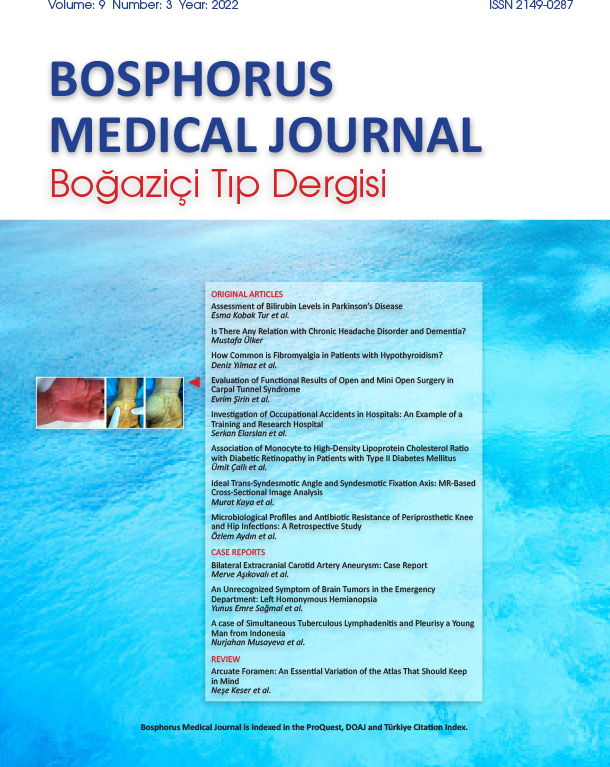Geriatrik Kalça Kırıklarında Tiroid Hastalıklarının Mortalite ve Klinik Sonuçlar Üzerine Etkisi
Olgun Bingöl, Güzelali Özdemir, Burak Kulakoğlu, Taner Karlıdağ, Enver Kılıç, Fatih İnciAnkara Şehir Hastanesi Ortopedi ve Travmatoloji Kliniği, Ankara, TürkiyeGİRİŞ ve AMAÇ: Bu çalışmanın amacı, geriatrik kalça kırığı olan hastalarda tiroid fonksiyon bozukluklarının postoperatif mortalite ve klinik sonuçlara etkisini araştırmaktır.
YÖNTEM ve GEREÇLER: Bu retrospektif çalışmaya Ocak 2019-Ekim 2020 tarihleri arasında kalça kırığı ile başvuran 139 hasta dahil edildi. Hastalar tiroid fonksiyon testlerine göre sırasıyla ötiroid, hipotiroid ve hipertiroid olmak üzere üç gruba ayrıldı. Grup 1 ötiroid sınırları içinde 97 hastadan, grup 2 hipotiroidili 18 hastadan ve grup 3 hipertiroidili 24 hastadan oluşturuldu. Tiroid bozukluklarının 30 günlük ve bir yıllık mortalite üzerine etkisi değerlendirildi. Ayrıca gruplar arasında yoğun bakım ihtiyacı ve yoğun bakımda kalış süreleri incelendi.
BULGULAR: Çalışmaya alınan hastalarda 30 günlük mortalite oranı %6,5, bir yıllık mortalite oranı ise %23,7 olarak bulundu. Çalışmaya alınan 139 hastadan 44'ünün yoğun bakıma alınması gerekti. Hipotiroidili hasta grubunda 30 günlük ve bir yıllık mortalite oranları sırasıyla %16,6 ve %22,2 olarak tespit edildi. Hipotiroidi grubunun %55,6'sı diğer gruplardan anlamlı olarak daha yüksek oranda yoğun bakım ünitesinde tedavi gördü (p=0,045). Çalışmaya alınan hastaların ortalama kalış süreleri 7,14±4,61 gündü. Grup 2'de ortalama kalış süresinin grup 1 ve grup 3'e göre daha uzun olduğu gözlendi, ancak bu fark istatistiksel olarak anlamlı değildi (p=0,330).
TARTIŞMA ve SONUÇ: Preoperatif dönemde hipotiroidili geriatrik kalça kırıklarında, postoperatif dönemde yoğun bakım ihtiyacı ve yoğun bakımda kalış süresi uzamıştır. Bu nedenle hipotiroidili geriatrik kalça kırığı olan hastaların perioperatif dönemde yakın takip edilmesi önerilmektedir.
The Effect of Thyroid Disorders on Mortality and Clinical Outcomes in Geriatric Hip Fractures
Olgun Bingöl, Güzelali Özdemir, Burak Kulakoğlu, Taner Karlıdağ, Enver Kılıç, Fatih İnciDepartment of Orthopedics and Traumatology, Ankara City Hospital, Ankara, TürkiyeINTRODUCTION: The aim of this study was to investigate the effect of thyroid dysfunctions on post-operative mortality and clinical outcomes in patients with geriatric hip fractures.
METHODS: In this retrospective study, 139 patients applied to the hospital with hip fractures between January 2019 and October 2020 were included in the study. The patients were divided according to thyroid function tests into three groups as euthyroid, hypothyroid, and hyperthyroid, respectively. Group 1 consisted of 97 patients within the euthyroid boundaries. Group 2 consisted of 18 patients with hypothyroidism and Group 3 consisted of 24 patients with hyperthyroidism. The effect of the thyroid disorders on 30-day and 1-year mortality was evaluated. Moreover, need for intensive care unit (ICU) and the length of stay (LOS) in ICU were examined between the groups.
RESULTS: The 30-day mortality rate in the patients included in the study was 6.5% and the 1-year mortality rate was found to be 23.7%. Forty-four of 139 patients included in the study needed for the ICU. The 30-day and 1-year mortality rates in the hypothyroid patient group were found to be 16.6% and 22.2%, respectively. About 55.6% of the hypothyroid group, significantly higher than the other groups, were treated in the ICU (p=0.045). The mean LOS of the patients included in the study was 7.14±4.61 days. The mean LOS in Group 2 was observed to be longer than in Groups 1 and 3; however, this difference was not statistically significant (p=0.330).
DISCUSSION AND CONCLUSION: In geriatric hip fractures with hypothyroidism in the pre-operative period, the need for ICU and the LOS in ICU increased in the post-operative period. Therefore, it is recommended that geriatric hip fracture patients with hypothyroidism should be followed up closely in the perioperative period.
Makale Dili: İngilizce




















